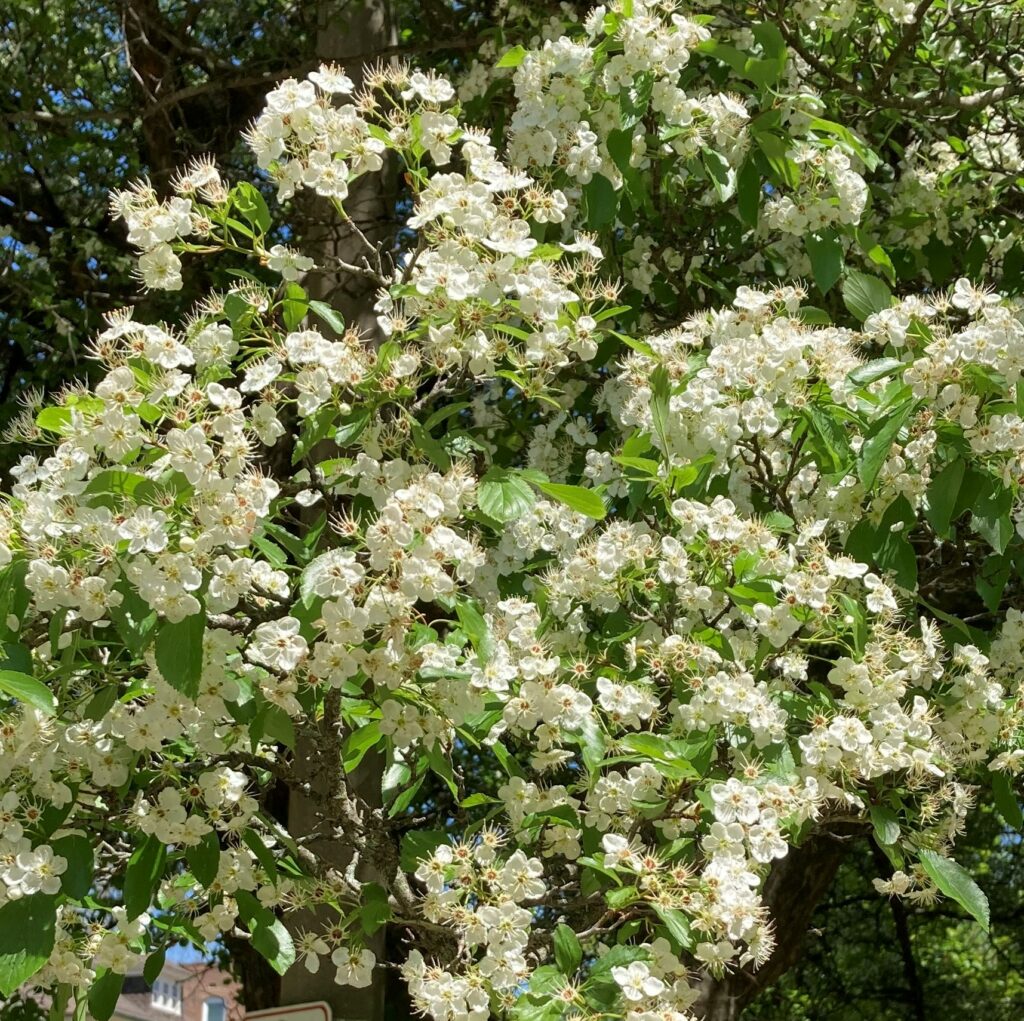By: Mark Halpin, Forestry Manager
We covered green hawthorn in a previous installment, but the Crataegus genus is worth revisiting for too many reasons to pass up. Hawthorn blooms are Missouri’s state flower and currently in full bloom, coming in right as the flowering dogwoods fade after a spectacular spring. Hawthorns are also a very important species in Missouri’s native ecosystems – we have around 75 native species, which are especially prevalent in the Ozarks. The flowers are important for pollinators and the fruit provides excellent sustenance for birds. These are also extremely tough trees, able to thrive in harsh conditions, although they are seldom used to their full potential due to their thorns. However, hawthorns are tolerant of heavy pruning and can easily be trained and “limbed up” to provide clearance to keep those thorns away from pedestrians. Beyond that, they need little structural pruning as they don’t get large enough to become hazardous, and their wood is so tough (Crataegus comes from the Greek kratos, meaning “strength”) that limb failures are rare.
These traits add up to make Hawthorns the “anti-dogwood” – tough, tolerant of abuse and lousy sites, and criminally underused. In so many landscapes where flowering dogwoods are left to suffer and wither, hawthorn would jump in and save the day if only given a chance. If our state tree is the “aristocrat of flowering native trees,” requiring soft and luxurious landscape conditions, hawthorn is the workhorse of native flowering plants, the heavy laborer who is content with the most bare comforts. A little water every now and then, a light meal of whatever loose nutrients the poor, compacted soil has to offer, and little else. Its prickly nature is just the price we have to pay to have such a beautiful tree arise from such ugly conditions. Outstanding wildlife benefits, a beautiful flower display and lovely fall color are surely worth it.
The major liability with these trees is really the cedar-hawthorn rust that can cause significant aesthetic damage to the leaves, fruit and stems (the flowers never seem to be affected). This is an interesting pathogen, as it requires two hosts to complete its 2-year life cycle. It develops orange-ish galls on cedar trees in fall (which actually serve as nice, ghoulish Halloween decorations) which overwinter and then release their spores in the spring. These find their way to hawthorns, where they cause leaf spots and withering of fruits and stems as they grow. Finally they release more spores that return to the cedar trees (which are not harmed by the disease). Which tree it infected first is a question best left to the philosophers. This rust can attack virtually any tree of the Rosaceae family, including crab apples, quince, and in very rare conditions, serviceberry (extremely wet weather promotes infections). This disease is rarely an issue in forest-dwelling hawthorns as they are protected from spore drift, but for landscape hawthorns it is quite common. If it becomes an issue for your hawthorn, and you can’t control the galls on local cedar populations by removing them, the best treatment is Bacillus subtilis (Serenade is a commonly available formulation). This is a natural bacteria that will attack the fungus without harming the beneficial insects that frequent hawthorns.
So keep the hawthorn in mind anytime you need a tough, beautiful tree. Just get a nice thick pair of leather gloves out when you prune it.




